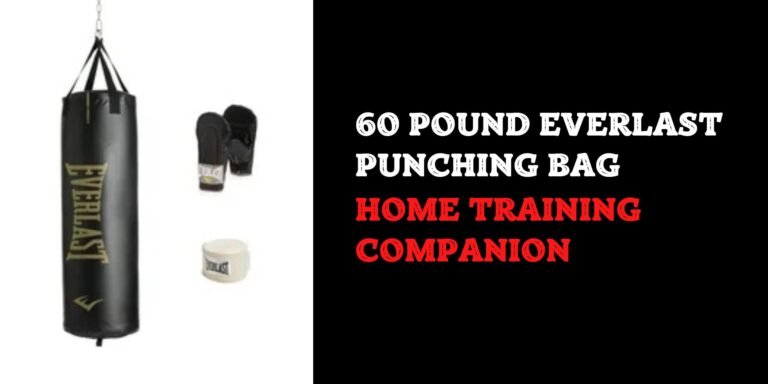In a world saturated with fitness fads and ever-evolving workout trends, one timeless training tool continues to stand out: the boxing bag. Whether you’re an amateur looking to shed a few pounds or an athlete sharpening your combat skills, the benefits of a boxing bag workout are undeniable. This comprehensive guide explores how incorporating this dynamic training method into your routine can transform your body, sharpen your mind, and elevate your fitness journey.
What is a Boxing Bag Workout?
A boxing bag workout typically involves striking a heavy bag using punches, kicks, elbows, or knees. Sessions may vary from high-intensity intervals to technique-focused drills, offering versatility for both cardio and strength goals.
Popular boxing bag types include the heavy bag, which is ideal for power punches and kicks, the speed bag that enhances rhythm, timing, and hand-eye coordination, and the double-end bag that is great for precision and reaction training. Whether used in a gym or at home, this workout offers full-body engagement and unparalleled versatility.
The Physical Benefits of a Boxing Bag Workout
Punching and kicking a heavy bag activates multiple muscle groups in the upper body, including the shoulders, arms, chest, and back. Your core muscles—abs and obliques—are also engaged for balance and torque, while the lower body works through legs and glutes during footwork and kicks. This makes boxing bag training a functional workout that enhances overall body strength.
Beyond building strength, a boxing bag workout is excellent for cardiovascular endurance. A 30-minute session can burn between 300 and 500 calories depending on intensity and body weight. Regular workouts can improve heart and lung capacity, stamina, VO₂ max, and even lower your resting heart rate over time.
Improved Coordination, Balance, and Core Strength
Striking a moving bag while maintaining proper footwork sharpens hand-eye coordination, spatial awareness, balance, and agility. These skills benefit not only boxers but athletes across many disciplines.
Every punch and pivot recruits your core, constantly engaging the midsection to build stability and strength. This not only sculpts your abs but also supports performance in other sports and physical activities.
Fat Loss and Muscle Definition
Because a boxing bag workout is both high-intensity and full-body, it helps burn fat while building lean muscle. The result is a more defined physique, with noticeable improvements in the arms, abs, and legs. Unlike traditional weight training, this method combines strength and cardio for maximum results in less time.
Mental and Emotional Benefits
Few workouts match the stress-relieving power of hitting a heavy bag. The rhythmic strikes act as a release for anger, frustration, anxiety, and tension. Along with this emotional catharsis, boxing stimulates endorphin production, leaving you feeling energized, uplifted, and more positive after each session.
Boxing also demands focus. Concentrating on form, timing, rhythm, and movement improves mental clarity and sharpens cognitive function. The mental challenge can help reduce fatigue and keep the brain as engaged as the body.
Boosted Confidence and Self-Esteem
Progress in boxing bag workouts whether it’s mastering a new combination, increasing your speed, or developing more power fosters a sense of accomplishment. This process builds confidence, resilience, and a strong sense of self-efficacy. Over time, you not only improve physically but also develop greater mental strength and self-belief.
Key Features of a Boxing Bag Workout
A boxing bag workout is highly adaptable, allowing you to control the intensity by adjusting round times, rest periods, and chosen techniques. Even a short 20–30 minute session can be more effective than longer, conventional workouts.
With minimal equipment a bag, gloves, and a timer you can train almost anywhere, whether at home, in the gym, or outdoors. Progress can be scaled over time by increasing speed, power, and endurance, making it suitable for beginners and advanced athletes alike.
Real-World Examples and Success Stories
Sarah, 32, began boxing after a stressful year at work. She lost 20 pounds but, more importantly, discovered a sense of empowerment. Hitting the bag became a form of therapy she didn’t know she needed.
Tom, 45, turned to boxing after his doctor warned him about high blood pressure. Three months later, his numbers dropped, and he felt ten years younger. Jason, 27, who plays amateur football, found that boxing bag drills dramatically improved his speed and balance on the field, enhancing his athletic performance.
How to Start a Boxing Bag Workout
To begin, you’ll need a heavy bag—either freestanding or hanging—along with hand wraps, gloves, and a timer or boxing app. A jump rope can be helpful for warming up, and a wall mirror or video recording can help you check and improve your technique.
A sample beginner routine might include a short warm-up with jump rope or shadow boxing, followed by rounds focusing on different punch combinations. For example, a first round could focus on jab-cross combos for speed, a second round on jab-cross-hook for power, a third on uppercuts or body shots, and a final round mixing techniques freely. Core work like planks and Russian twists can be added before cooling down with stretches.
Safety Tips and Best Practices
Always wrap your hands properly to prevent wrist and knuckle injuries, and use high-quality gloves for joint protection. Stay hydrated before and after training. A thorough warm-up and cool-down reduce injury risk and improve recovery. Most importantly, listen to your body—rest when needed and avoid overtraining to keep your progress sustainable.
Additional Benefits to Consider
Boxing bag workouts are incredibly versatile. They can be done at home, in group classes, with personal trainers, and both indoors and outdoors. This flexibility makes it easier to stick to your fitness goals without feeling restricted.
It’s also an affordable option. A basic setup of a bag and gloves often costs less than a gym membership, making it budget-friendly while still delivering high-level fitness results. Additionally, because you’re training with a bag rather than a live opponent, the risk of injury is far lower than in sparring, yet you still gain the benefits of improved technique and power.
Another overlooked advantage is the mental toughness that develops over time. Committing to a regular boxing routine builds discipline, consistency, and emotional resilience— qualities that extend beyond the gym into daily life.
Conclusion
Boxing bag workouts deliver powerful physical and mental benefits in a single, high-energy package. They improve strength, burn fat, enhance focus, and relieve stress, making them one of the most efficient and empowering fitness options available.
This form of training is accessible to all fitness levels, easy to scale, and endlessly engaging. As you punch your way through each round, you’re not just burning calories—you’re building the strongest, most confident version of yourself.
FAQs
What muscles does a boxing bag workout target?
Primarily shoulders, chest, back, arms, abs, and legs. It’s a full-body workout.
Is it suitable for beginners?
Yes. Start slow, focus on form, and increase intensity gradually. Apps and online tutorials can guide beginners.
How often should I do it?
2–3 times a week is effective for fitness and fat loss. Advanced users may train more frequently.
Do I need boxing experience?
No prior experience is needed. Proper technique can be learned via tutorials, personal trainers, or local boxing gyms.
Can it replace my gym workouts?
Yes, if your goal is general fitness, weight loss, and conditioning. For strength or hypertrophy goals, combine it with weight training.
What should I wear for a boxing workout?
Comfortable athletic clothing, supportive shoes, hand wraps, and boxing gloves are recommended.
Can women benefit from boxing workouts?
Absolutely. Boxing empowers women by improving strength, confidence, and overall fitness without bulking.




